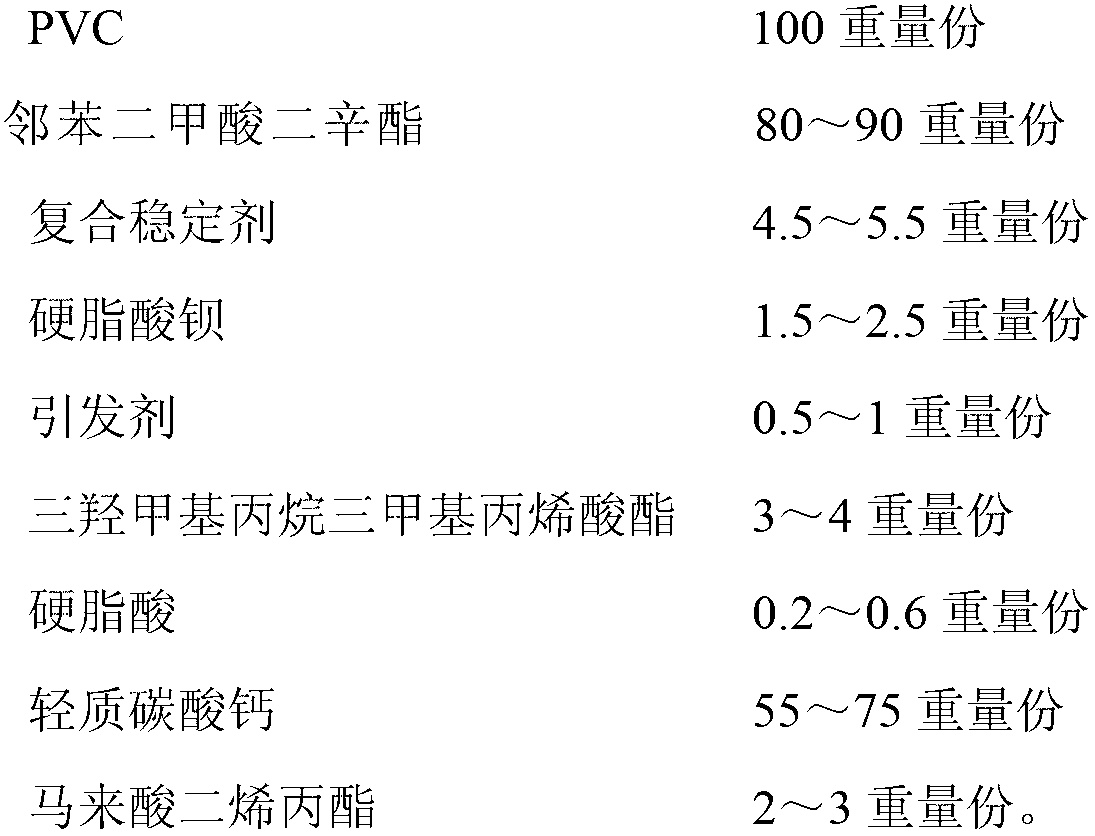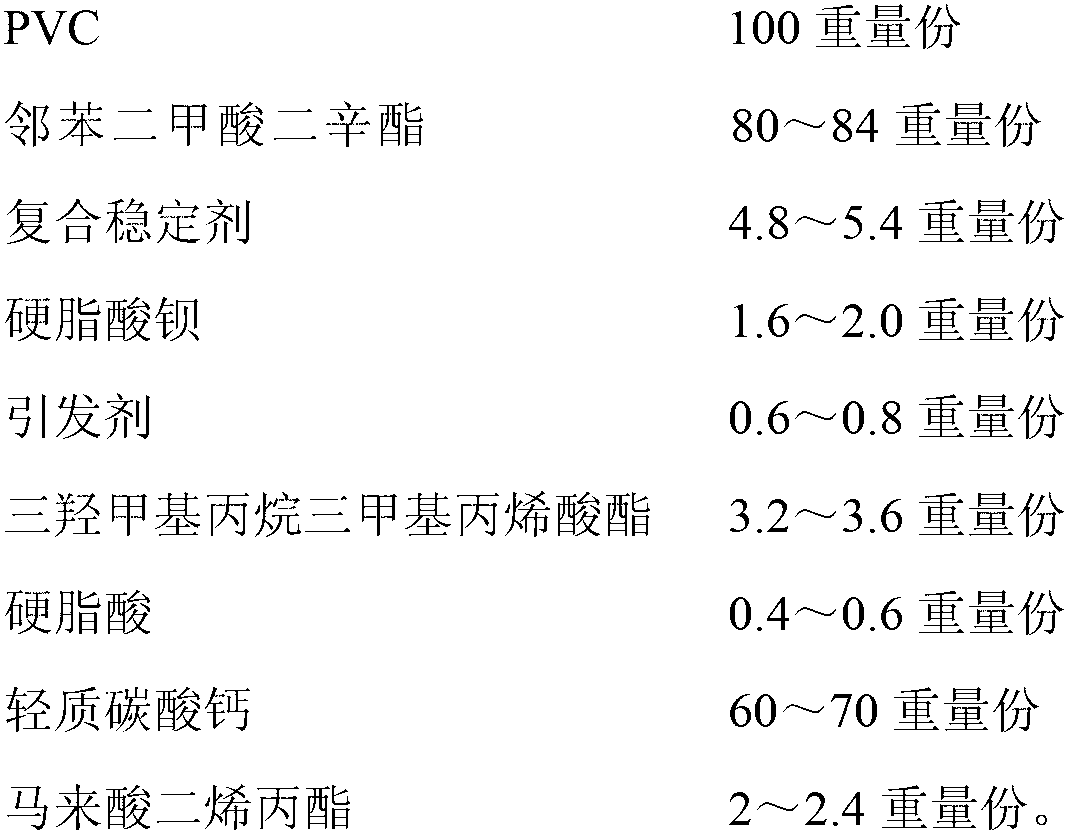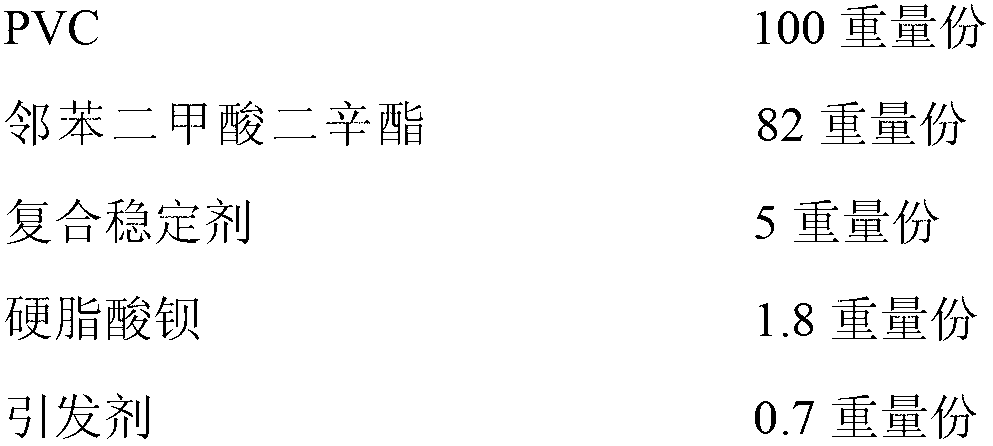Polyvinyl-chloride extinction material and production method thereof
A matting material, polyvinyl chloride technology, applied in the chemical industry, can solve the problems of high gloss, not reaching the matt of rubber materials, etc.
- Summary
- Abstract
- Description
- Claims
- Application Information
AI Technical Summary
Problems solved by technology
Method used
Image
Examples
Embodiment 1
[0021]
[0022] production method:
[0023] 1. High-speed mixing: first mix PVC, DOP, compound stabilizer, barium stearate, stearic acid, and light calcium carbonate in a high-speed mixer at a high speed of 200 rpm for 8-9 minutes, then add the initiator For DCP, TMPTMA and DAM, stir at a low speed of 80 rpm for 1.5 to 2 minutes before discharging.
[0024] 2. Internal mixing: Mix the powder that has been cooled to 50-60°C in an internal mixer for 9-10 minutes, and the temperature used for mixing is 110°C.
[0025] 3. Reactive extrusion: Extrude and granulate in a twin-screw extruder, the screw speed is 60 rpm, and the temperature is set as shown in the table below:
[0026] area barrel zone 1 barrel zone 2 Barrel 3 zone Barrel 4 zone Barrel 5 zone Barrel 6 zone Barrel 7 zone nose
temperature 120~130℃ 130~140℃ 140~145℃ 150~160℃ 160~170℃ 160~170℃ 155~165℃ 140~150℃
[0027] The performance measurement of the polyvi...
Embodiment 2
[0030]
[0031] production method:
[0032] 1. High-speed mixing: first mix PVC, DOP, lead cyanurate compound stabilizer, barium stearate, stearic acid, light calcium carbonate in a high-speed mixer at a high speed of 200 rpm for 8-9 minutes Then add the initiators DCP, TMPTMA, and DAM, stir at a low speed of 80 rpm for 1.5 to 2 minutes, and then discharge.
[0033] 2. Internal mixing: Mix the powder that has been cooled to 50-60°C in an internal mixer for 9-10 minutes, and the temperature used for mixing is 120°C.
[0034] 3. Reactive extrusion: Extrude and granulate in a twin-screw extruder, the screw speed is 60 rpm, and the temperature is set as shown in the table below:
[0035] area barrel zone 1 barrel zone 2 Barrel 3 zone Barrel 4 zone Barrel 5 zone Barrel 6 zone Barrel 7 zone nose
temperature 120~130℃ 130~140℃ 140~145℃ 150~160℃ 160~170℃ 160~170℃ 155~165℃ 140~150℃
[0036] The performance measurement of t...
Embodiment 3
[0039]
[0040] production method:
[0041] 1. High-speed mixing: first mix PVC, DOP, lead cyanurate compound stabilizer, barium stearate, stearic acid, light calcium carbonate, and stir in a high-speed mixer at a high speed of 180 rpm for 8-9 minutes Then add the initiators DCP, TMPTMA, and DAM, stir at a low speed of 100 rpm for 1.5 to 2 minutes, and then discharge.
[0042] 2. Internal mixing: Mix the powder that has been cooled to 50-60°C in an internal mixer for 9-10 minutes, and the temperature used for mixing is 130°C.
[0043] 3. Reactive extrusion: Extrude and granulate in a twin-screw extruder, the screw speed is 60 rpm, and the temperature is set as shown in the table below:
[0044] area barrel zone 1 barrel zone 2 Barrel 3 zone Barrel 4 zone Barrel 5 zone Barrel 6 zone Barrel 7 zone nose
temperature 120~130℃ 130~140℃ 140~145℃ 150~160℃ 160~170℃ 160~170℃ 155~165℃ 140~150℃
[0045] The performance measu...
PUM
 Login to View More
Login to View More Abstract
Description
Claims
Application Information
 Login to View More
Login to View More - R&D
- Intellectual Property
- Life Sciences
- Materials
- Tech Scout
- Unparalleled Data Quality
- Higher Quality Content
- 60% Fewer Hallucinations
Browse by: Latest US Patents, China's latest patents, Technical Efficacy Thesaurus, Application Domain, Technology Topic, Popular Technical Reports.
© 2025 PatSnap. All rights reserved.Legal|Privacy policy|Modern Slavery Act Transparency Statement|Sitemap|About US| Contact US: help@patsnap.com



